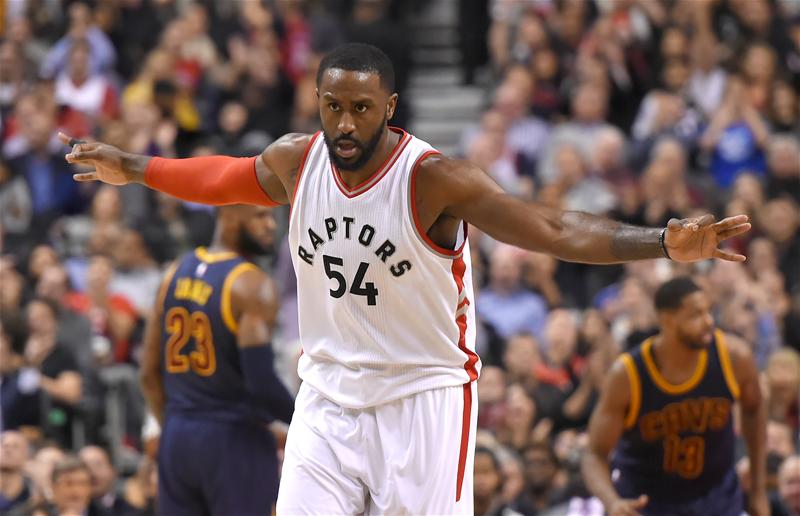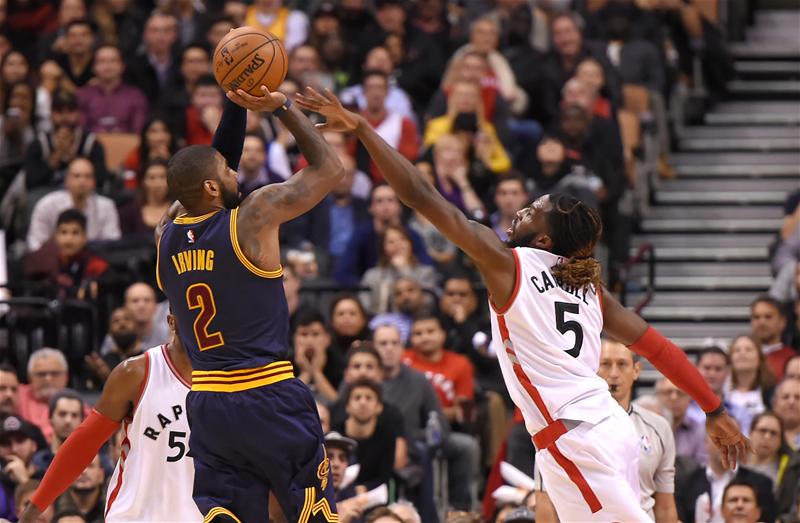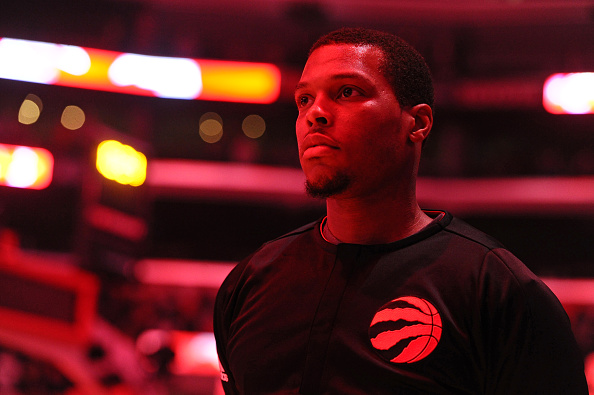“Energy, energy, energy, energy. Buzz Lightyear, boy, from here to infinity” – RZA
To hear the Toronto Raptors tell it, the reason for their evolution into an offensive juggernaut has a lot to do with the energy of the basketball.
This is not a scientific matter, of course, with the jury still out on Space Jam’s hypothesis as to the ability of leather to absorb human energy, but the belief is that the more hands that touch the ball, the more it moves, the more balanced the offense, and the more a team shares, the more energy the ball gains. From there, players can better find a rhythm, and the feedback loop creates a virtuous cycle where ball movement begets effectiveness which improves confidence which leads to more ball movement.
That’s something DeMarre Carroll experienced with the ethereal Atlanta Hawks of 2014-15, a success that was somewhat fleeing but one he thinks the Raptors may be able to replicate, at least as far as making life hell on opposing defenses by broadening their decision set.
“You make it hard for other teams to guard you by moving the ball,” he said Saturday. “I think we’re building on it. We’re trusting each other, guys are knocking down their shots and that’s what you have to do if you want to be a high caliber team.”
Whatever the root cause, what the Raptors are doing is proving effective – in last night’s narrow loss to the Cleveland Cavaliers, they managed to score 112 points, the 14th time in the last 15 games that the Raptors have cracked 100 points. The Raptors own the NBA’s No. 2 offense, one that is functioning at nearly historic levels, as ESPN’s Kevin Pelton pointed out yesterday. Monday’s loss also marked the eighth consecutive game in which they’ve reached an Offensive Rating of 116 or higher, a mark that would have led the NBA a season ago.
After starting off the season relying heavily on DeMar DeRozan to score at ridiculous rates while the shooters around him struggled, the Raptors have shifted to a more balanced attack. That’s both because DeRozan has cooled down some and because opposing defenses are selling out to stop him. Recognizing traps and blitzes, DeRozan’s become more selective about the shots he takes, instead shifting into more of a facilitator role. He’s averaged a career-high 4.3 assists and hasn’t recorded fewer than four in a game in nearly a month, a 13-game stretch. DeRozan’s improvements as a scorer stand out, but it might be the leap he’s taken as a decision-maker and a passer that push the Raptors to the next echelon on the offensive end.
“There’s a lot more space and it’s on me to make the right pass,” DeRozan explained Saturday. “Lately I’ve been trying to get the scent off me by passing to get guys open shots that we were missing early on and now we’re knocking them down.”
The idea of shots dropping now that weren’t before is accurate, as the Raptors are producing a somewhat similar proportion of open looks. The 3-point shot, in particular, is a high-variance shot that will move up and down throughout the season. When shots aren’t falling like early in the season, people will ascribe a reason for it, like they are now with the makes and the additional rhythm more passing is affording. It’s a make-or-miss league (or a make-or-miss-or-make-but-your-foot-is-out-of-bounds league, as it were), as head coach Dwane Casey is fond of repeating.
“Right now we’re hot,” Patrick Patterson, perhaps the team’s most hot-and-cold shooter, said. “We’re making shots. Early on in the season we were missing shots. Right now it seems like the ball was finding the net. Hopefully we can continue that for the rest of the season.”
To be clear, the Raptors’ offense functioning so well is a product of more than just making shots. Even when they’re not canning open looks, the Raptors do some other things well that ensure their offense has a high floor. Essentially, they may not score the most efficiently on each shooting possession, but they value each possession so highly that they “waste” fewer of them than most any other team. To wit, the Raptors have the third-lowest turnover rate in the league, rarely killing a possession in its infancy. They’re also eighth in offensive rebounding rate, extending the possessions on which they fail to score initially. And, as always, they’re elite at getting to the free-throw line (they’re third in free-throw attempts per-field-goal attempt), an element of offensive efficiency many seem to forget about (or look past, erroneously thinking free throws dry up in the playoffs). There’s also a bit of a misnomer that the Raptors’ offense is somehow anti-analytics because DeRozan doesn’t shoot threes, and while the Raptors aren’t a high-volume 3-point shooting team (20th in attempts), they are top-five in 3-point percentage (third) for a second year in a row, so they make the most of them.
What’s interesting about the upturn in offense and the discussion around how the Raptors are sharing the ball more is that they’re still not actually passing all that much, just making the most of the passes they make. The Raptors rank 29th in passes made per-game and 28th in potential assists, but they’re ninth in adjusted assist to pass percentage ratio (in other words, they produce points via assist at a top-10 rate when they do actually pass). They’re actually passing less than last year, when their sticky offense ranked fifth in the league, just passing with more purpose or efficacy. Even over the last eight games, when their offense has pushed even higher, the Raptors rank 29th in passes and 27th in potential assists, they’re just converting those passes to assists and points at a top-five rate.
Whether or not the idea of the ball gathering energy is true, the Raptors believing it to be true is important. If the shots that extra passing creates weren’t dropping, none of these good vibes would exist. The fact that they are, and that they do, informs how the Raptors may approach things moving forward. If they believe balance is working for them, this trend toward a more communal attack should continue, and the result will be a more aesthetically pleasing form of basketball, with the stars drawing attention to create openings elsewhere and the role players knocking down the resultant looks, swinging the ball, or putting it on the floor and creating even bigger breakdowns. The Raptors are often cited as lacking a third star, and that’s true, but they have a bevy of complimentary players who can all shoot, drive, and pass just enough to keep things humming.
“I’m a firm believer in when that ball’s zinging around, it gets a rhythm and has energy in it. That’s kinda where the ball is now. I like the way the ball’s zinging around, moving around, and not just in one guys’ hand. And Demar is doing a great job of making sure he’s finding his teammates,” says Casey. “The ball is finding the right person. When you move the ball like that, it has energy inside it and I think it helps us on the other end when the ball is moving like that.”
Moving from “this is unsightly but it really works” to “this is fun and it really works” is a weclome change of pace for the Raptors. Even if the passing isn’t increasing in quantity, and even if some of the recent surge is due to the variance in 3-point percentage, the increase in passing quality and the willingness to make those passes is important. An elite offense that’s stalled out in the postseason on multiple occasions needs to find even greater means of scoring, and the Raptors believing in the energy of the basketball could wind up being a self-fulfilling prophecy that makes them tougher to defend come April.




